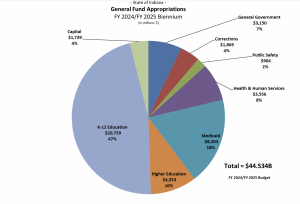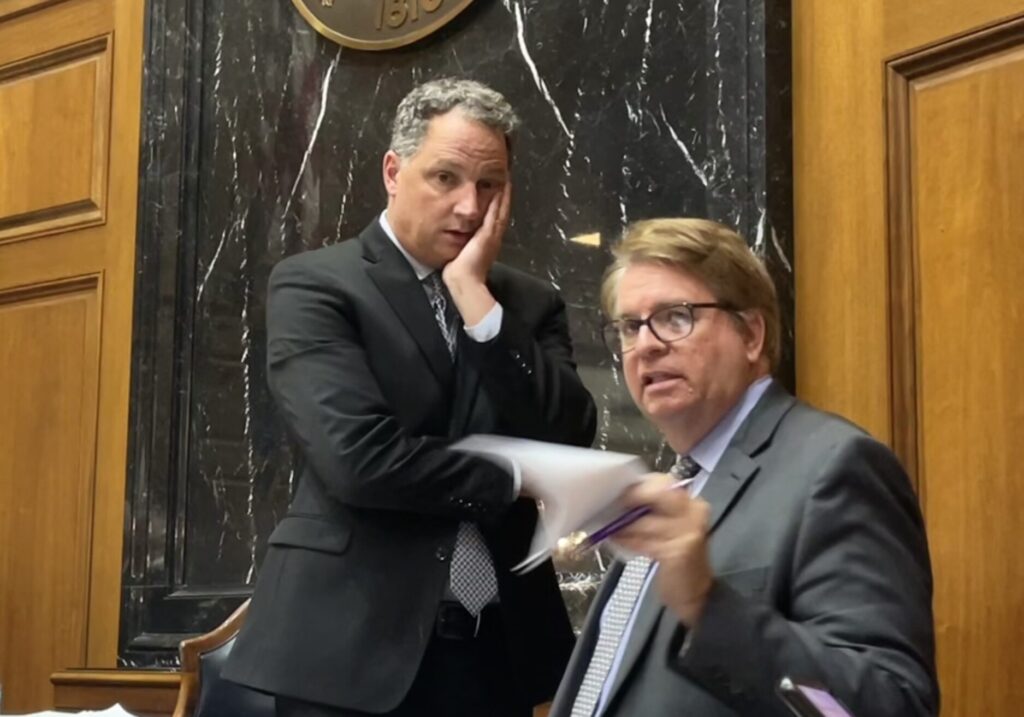Subscriber Benefit
As a subscriber you can listen to articles at work, in the car, or while you work out. Subscribe NowOutrage from public school officials over dismal funding in a two-year state budget proposal prompted lawmakers to add a twelfth-hour K-12 boost to Indiana’s spending plan on the chaotic final day of this year’s Indiana General Assembly.
Even as rumors circulated for hours Thursday on what prompted multiple draft budgets, Republican leadership declined to identify the hold-up, not publicizing the final version’s release until 9 p.m. and delaying the Legislature’s final approval of the budget and the end of this year’s legislative session until the wee hours of Friday morning.
Under pressure from their members, Republican leaders opted to decrease the amount dedicated to paying down the Pre-1996 Teacher Retirement Fund—the state’s only unfunded debt obligation. Rather than the $1 billion previously allotted, that fund will now receive an additional $700 million in the coming biennium and an additional $312 million will go toward K-12 schools.
Senate President Pro Tem Rodric Bray, R-Martinsville, said issues with the final budget came when trying to combine the Senate and House versions, which took different approaches to education funding.
“The bottom line is that there was a misunderstanding in the way we had it drafted and so when we took a look at the school runs, it wasn’t what we intended to have happen,” Bray said. “There wasn’t as much money in there for the traditional public schools and so we had to start over.”
The budget advanced on a 70-27 vote in the House, with one Democrat—Rep. Rita Fleming, D-Jeffersonville—joining Republicans to pass the measure.
Across the Statehouse hall, the diversion of traditional school funding to private and charter school vouchers is what prompted Sen. Vaneta Becker, R-Evansville, to vote against the budget. Another Republican senator, the embattled Mike Young, announced from the podium that he wouldn’t be staying to vote and left just before 1:30 a.m.
Even without their votes, the Senate’s Republican majority passed the budget on a 39-10 vote, with Sen. David Niezgodski, D-South Bend, voting yes.
“It’s not just your average ordinary typical two-year budget. It’s a generational impact budget,” said Gov. Eric Holcomb at a 3 a.m. press conference. “Its policies and plans can be viewed as we do as a blueprint for growth.”
What’s in it for education?
Republican budget writers announced Wednesday they would earmark more than $1 billion for a major expansion of school vouchers. With that move, GOP leaders touted an 8% increase in overall K-12 tuition support formula over the biennium with voucher funding growing 69% the first year and 14% the second year.
That prompted a flurry of pressure from public school officials Wednesday night. Denny Costerison, executive director of the Indiana Association of School Business Officials, told the Indiana Capital Chronicle those school funding projections showed that about 75% of Hoosier school districts would receive funding increases of less than 2% in the budget’s second year.

Late Thursday, legislative leaders announced a last-minute change to the budget in an effort to ease backlash. Multiple lawmakers were also reportedly unhappy to learn that their school districts received so little money after the voucher expansion.
Now, those per student funding increases have improved somewhat to 5.3% in the first year, and 1.8% the next. With the change, schools will see $8.84 billion for tuition support in fiscal year 2024, and $9.03 billion in fiscal year 2025.
That’s $312.1 million more over the biennium—an additional $148 million in year one of the budget, and $164 million the second— compared to the earlier draft of the budget. Since vouchers get a portion of this funding, their spending also increased.
At his own local schools in Fort Wayne, House Minority Leader Phil GiaQuinta said school funding increased by 1.6% the first year and actually decreased by 0.6% in the second year.
“Last week, we find out we have $1.5 billion extra and my school district is losing money. Even with the additional funds (the second year is) negative 0.4%,” GiaQuinta said. “There’s no doubt that played a part into some of the last-minute scrambling over extra dollars.”
What about that pay raise?
The state’s highest offices still got a significant pay raise in the final version of the budget–even though the language never got any public vetting during the chaotic final hours.
“We wanted to put them on par with the other leaders in government, like the chief justice,” Huston said. “I think the (attorney general) salary ends up being comparable to a prosecutor salary and… the Senate brought the language and we agreed it probably needed to be changed and this was the opportunity to change it.”
Huston said the Senate had previously discussed salary increases but hadn’t quite settled on language before senators introduced their version of the budget a few weeks ago.
“I think there’s been a lot of conversation over the years about the disproportionate pay of our elected officials,” Huston said.
The annual salary of the state’s highest court judges is currently at $198,513.
The budget also includes Gov. Eric Holcomb’s compensation package to increase pay for the typical state employee by 5%. And a separate provision increases starting salaries for state troopers to $70,000 per year.
But not everyone was happy with the pay raise language.
Lt. Gov. Suzanne Crouch, whose office would get a 60% bump, signaled her disapproval over Legislature’s failure to give the public a chance to offer input on a pay raise proposal.
“If it’s something that’s important to do, and if the work we do really reflects a higher salary – which I’m not arguing against – it should be part of the process,” Crouch said. “It should be… discussed and vetted and people should be able to weigh in.”
Crouch is running for governor in 2024, an office that will get a 48% raise. The raises go into effect on Jan. 1, 2025, at the end of the current term.
Bray said that those offices were “woefully underpaid” in comparison to other states.
“Not a one of them asked for it,” Bray said. “Frankly, it was a fairly easy decision.”
The Indiana Capital Chronicle is an independent, not-for-profit news organization that covers state government, policy and elections.
Please enable JavaScript to view this content.


I don’t have any problem with pay raises – I think everyone should be paid fairly: teachers, governors, troopers – but I do have trouble with the group of legislators who don’t want to follow a public and transparent process for making those decisions.
I don’t care how noble your pursuit is – rushing it through in an after-dark session makes it seem sinister.
I’m a bit curious about how the increased spending on K-12 education will be spent. I hope it’s not on administrative matters or keeping underutilized facilities open.
what verifications are there on that $1 billion to make sure it isn’t going to profit people rather than educate kids? Are there the same restrictions on those funds that our public schools have to address?
Also – Am I reading that correctly – they are pulling the funds from what would have gone to the teacher retirement fund (a debt the state owes)? That almost sounds like the teachers are now covering the cost of running our schools with what should have been their retirement funds. The optics on this seem a little….wrong.
Beyond the funding…When will the State of Indiana put ALL SCHOOLS on the same level playing field? Segregation by choice- don’t forget though the public schools have to educate everyone with bureaucratic policies….”counsel them out” back to boundary schools… and you thought an “invisible fence” was for pets.